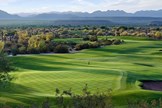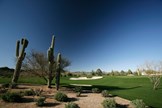More than just desert: The best golf courses in Scottsdale, Arizona
Last updated:
Scottsdale, Arizona is home to some of the USA’s best golf courses, but the words ‘desert’ and ‘golf’ that probably don’t seem like a natural fit to most UK golfers. The uninitiated will probably take a few holes/halves/courses/days to get used to what they are seeing, playing the game in the Sonoran Desert is definitely an experience you should savour at least once. The whole scene with its lush green fairways, desert flowers, and numerous water features, might seem a bit surreal at first, but after reflecting on your round you’ll probably recognize a lot of the characteristics you love about courses in Britain and Ireland are actually evident here too.
The natural terrain and contours are usually used to great effect and, sometimes, the only conspicuous difference between Scottsdale and Surrey, is that, instead of fairways bordered by heather and pines, you find rocks, sand, cacti, Chuparosa, and Firecracker Penstemon. That said, target-golf has its roots in the desert and there are definitely a lot of manufactured features and contrived holes that, like the expensive golf in Las Vegas, seems to rely more on looks than substance. Yes, there are plenty of holes where the ground-game will come in useful, but a lot of the time it just won’t work.
Red Lawrence’s excellent Desert Forest GC, which opened in 1962, is usually considered Arizona’s first desert course, but there are now close to 200 places to tee it up in the Greater Phoenix area. Technically a city by itself, Scottsdale is really an upmarket suburb of Phoenix where you’ll find the very best examples of desert golf., especially in the vast open spaces north of the urban area. Most of the great golf here was designed by Jack Nicklaus, Tom Fazio and Tom Weiskopf and belongs to exclusive private clubs with exorbitant initiation fees (usually $100,000+). There are a few public facilities, however, and though the green fees might sting a bit, but they’re definitely a splurge worth making.
The 10 Best Golf Courses in Scottsdale, Arizona
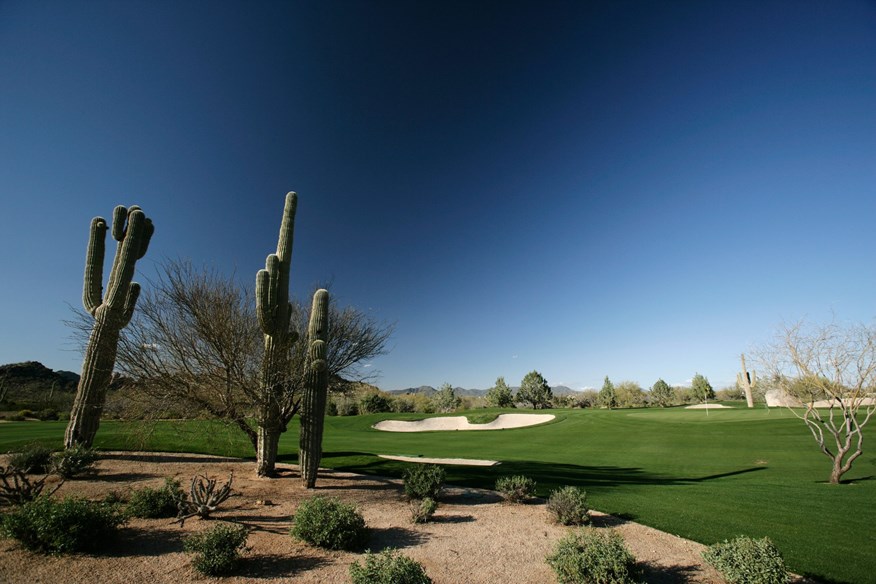
1. Whisper Rock (Lower)
Course details: 7,490 yards, par 72
Green fee: Private
Website: whisperrockgolf.com (unless you’re a member, the image on the home page is all you’ll see. But it’s worth a quick visit)
Telephone: 480-575-8700
When Whisper Rock opened in 2001, it quickly became the best ‘hang’ in the desert, a place where PGA Tour pro members, and other prominent individuals, could enjoy a quiet game and post-round drink away from prying eyes. The Lower was the first of the club’s two courses to open and was designed by Gary Stephenson with considerable input from Phil Mickelson who was determined to make his debut design something special.
The recipe for successful golf in Scottsdale is flawlessly-green surfaces; attractive desert areas (with boulders, grit, low-lying shrubs, wildflowers, Saguaro (pronounced sa-wah-ro) cacti, and maybe a few native trees – palo verde, juniper, mesquite, and ironwood) to the side of fairways or short of greens giving it its ‘target golf’ quality; large, undulating putting surfaces; large, shapely bunkers that add an element of menace; and the odd water feature. And Whisper Rock’s Lower Course gets it more right than virtually every other course in the area. It is, in short, absolutely gorgeous.
Unlike a lot of desert holes, the Lower Course’s are surrounded with short-grass chipping areas that help its designer emphasize the quality of his short game.
2. Estancia
Course details: 7,256 yards, par 72
Green fee: Private
Website: estanciaclub.com
Telephone: 480-473-4400
Desert golf and Tom Fazio were made for each other. The architect with more designs in America’s top 100 courses than any other (according to multiple publications), Fazio frames holes and does beauty, eye candy, and visual stimulation characteristics that go down very well in places like Scottsdale (Las Vegas and Palm Springs, too).) – better than anybody. Of course, a club’s financial health and the skill of the superintendent (greenkeeper) play a very important role in a course’s appearance, but Fazio has earned the right to build these well-funded monuments to capitalism, because he delivers virtually every time.
That certainly isn’t to say Fazio designs are soulless and a little vapid at times, but it seems more importance is often attached to how they look than how they play.
Estancia was the Philadelphia native’s first course in Scottsdale (it opened in 1996) and is part of a very private club. A thoughtful routing gives golfers a different view of the desert or city on every hole, though North Scottsdale’s best-known landmark, Pinnacle Peak, is never far out of shot. There is a variety of uphill and downhill shots, wide fairways afford several options off the tee, and fast greens with significant breaks can make some outs a nervy proposition.
3. Troon Country Club
Course details: 7,041 yards, par 72
Green fee: Private
Website: trooncc.com
Telephone: 480-585-4310
Scottsdale began life as a small farming community in the late 1800s and grew significantly during the 1920s when tourists came for the climate. The Great Depression virtually stopped its progress, however, and it wasn’t until the post-WWII years, and the 1980s and ‘90s in particular, when the city’s population and prosperity soared.
Canadians and people from states in the north of the U.S. retired to the desert in great numbers and those who spent the summer months in their hometowns before coming to Scottsdale for the winter earned a nickname – snowbirds. These people wanted to play golf, and Scottsdale, with its perfect winter weather, space, beauty, and cash became one of America’s great golf destinations. Red Lawrence’s Desert Forest had been a popular course since opening in 1962, but it remained virtually alone until the mid-1980’s when the Scottsdale golf boom began.
Troon Country Club was one of the first courses to arrive and it did a great deal to show what was possible. Designed by Tom Weiskopf (who had won the Claret Jug at Royal Troon in 1973, of course), together with desert specialist Jay Morrish, the course is an interesting mix of ground-game-friendly approaches and target-style holes where, if you miss the cut-and-prepared, you’re likely to find yourself in a spot of bother. With wonderful views of Pinnacle Peak and the McDowell Mountains, a few miles to the south, Troon Country Club is a lovely day out and a sought-after tee-time.
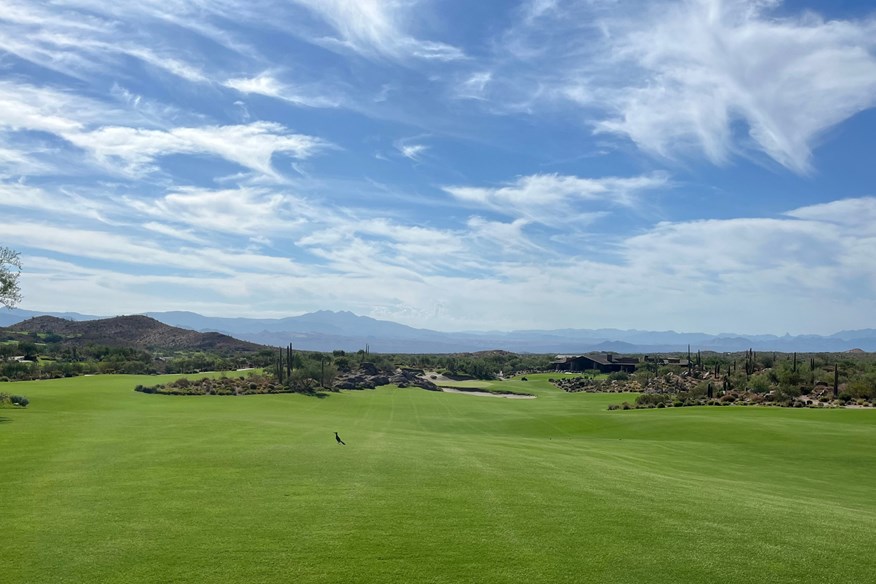
4. Scottsdale National (Mine Shaft)
Course details: 7,579 yards, par 72
Green fee: Private
Website: sngc.com
Telephone: 480-443-8868
A former U.S. Marine who served in Vietnam, Bob Parsons founded web-hosting company, GoDaddy, in 1997 and, 14 years later, sold 70% of it to a private equity consortium for over $2 billion (his current net worth is estimated at $4 billion). In 2013, the keen golfer and entrepreneur who founded PXG, who is also said to have spent over $250,000 a year on his golf habit, bought the Golf Club of Scottsdale to add to his growing list of Phoenix-area properties. An exclusive private club, the Golf Club of Scottsdale had failed to weather the financial storm following the economic downturn and, at the time of purchase, had only 160 members.
Parsons bought it for just $600,000 and immediately changed its name to Scottsdale National. In 2014, he paid a reported $55 million for an adjoining 223-acre parcel and, with further land purchases, announced a $35 million investment in his new club to include a rebuild of the course and a new clubhouse.
After rebuilding the original course (renamed The Mine Shaft), the design firm of (Tim) Jackson and (David) Kahn added The Other Course and Bad Little Nine in 2016. The original layout had been designed by Dick Bailey and Jay Morrish and opened in 2003. Jackson and Kahn used some heavy machinery and dynamite in rebuilding it, creating an exceptional layout which, thanks to its owner’s deep pockets, occupies pristine territory with no houses on its edges and incredible views of the McDowell Mountains.
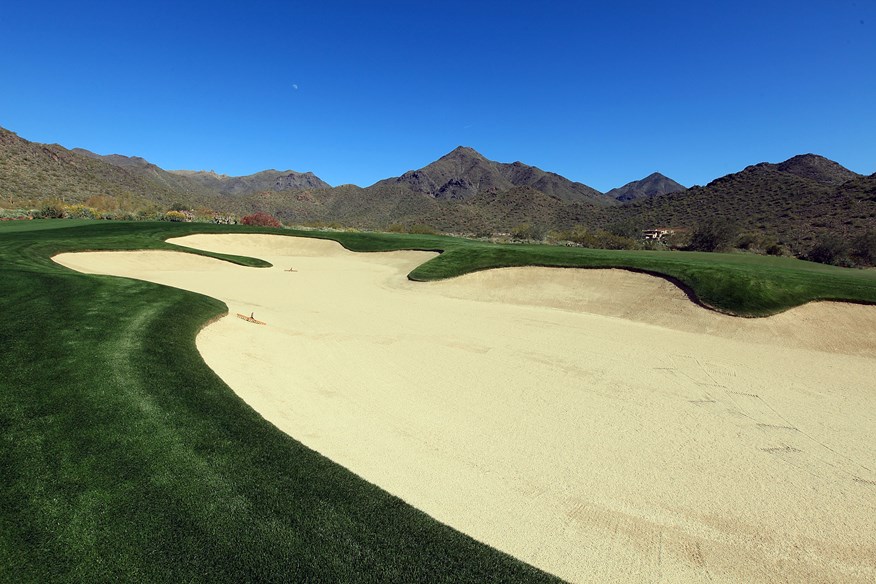
5. Silverleaf
Course details: 7,392 yards, par 72
Green fee: Private
Website: silverleafclub.com
Telephone: 480-515-3200
What can you say about Silverleaf other than it is another superb desert course, created by Tom Weiskopf? All the elements of Scottsdale’s top-quality layouts are here including the huge, attractively-shaped bunkers and large, action-packed greens that adorn Weiskopf’s desert designs. Panoramas of the McDowell Sonoran Preserve are pretty special, too.
The almost 7,400-yard course is located in the 8,300-acre Silverleaf community (part of the 43-000-acre DC Ranch, first settled in 1901) which was named after a long-gone silver mine and possesses perhaps Scottsdale’s finest clubhouse, a 50,000sqft Mediterranean-style structure that houses a world-class spa as well as restaurants you’d never believe could be found at a golf club. If you can snag a tee-time on the golf course, have fun trying to beat Jon Rahm and Tony Finau’s course record of 59.
6. Desert Mountain (Chiricahua)
Course details: 7,347 yards, par 72
Green fee: Private
Website: desertmountain.com
Telephone: 480-595-4110
If you’re reading these reviews (especially in the Las Vegas and Scottsdale sections) and shaking your head at what appear to be AI-generated images of golf courses with otherworldly conditions, over-the-top clubhouses, and which cost absurd amounts of money to build, then you are most assuredly not alone. The scale of some of these places can be hard for British golfers to grasp, but don’t worry, there are plenty of Americans who find them a bit excessive too. The most improbable, preposterous private golf clubs in the U.S. are surely PGA West (where four of the nine courses are open to the public) in La Quinta, California, and Desert Mountain in Arizona.
First developed in 1986 and drawn up by Taliesin Associated Architects which was founded by the great Frank Lloyd Wright, Desert Mountain currently has over 2,000 homes, is spread across 8,000+ acres, and lies 30 miles north of downtown Scottsdale. It is home to six Jack Nicklaus-designed courses and a seventh (called ‘No. 7’ and a par-54 of 3,114 yards) that was added in 2019 and designed by club members Bill Brownlee and Wendell Pickett. Chiricahua (a division of the Apache Tribe) was the fifth of Nicklaus’s designs at Desert Mountain and opened in 1999. It possesses more changes in elevation than its Desert Mountain neighbours and, because it rises to 3,300ft, enjoys much cooler temperatures than courses lower down. Each layout at Desert Mountain has won its share of awards and accolades, but Chiricahua is usually rated the members’ favourite.
7. Troon North (Monument)
Course details: 7,039 yards, par 72
Green fee: $500
Website: troonnorthgolf.com
Telephone: 480-585-7700
Troon North was the first upscale public course in Scottsdale and gives public golfers the opportunity to experience the best of desert golf. With the Estancia Club just across the road and Whisper Rock, Desert Highlands, and Scottsdale National about a mile away, Troon North sits in some of the finest desert property in Scottsdale and has a number of holes the equal of any at its prestigious neighbours.
The Tom Weiskopf/Jay Morrish design opened in 1990 and, perhaps strangely for a desert course, pays homage to the Open Championship with more bump-and-run opportunities than elsewhere. Pinnacle Peak comes into view often and the course is surrounded by massive boulders, one of which actually stands in the middle of the fairway at the par-5 3rd hole. A look at the aerials on Google Earth tells you that, while the nearby private clubs are mostly free of nearby houses, the courses at Troon North are part of a fairly substantial neighbourhood. But the planning is done so well here and the houses themselves not jammed in like they are at so many developments in Arizona, California, and Florida, so they really aren’t a bother. And they certainly don’t impair your enjoyment of a spectacular desert course.
8. Desert Mountain (Renegade)
Course details: 7,933 yards, par 72
Green fee: Private
Website: desertmountain.com
Telephone: 480-595-4110
Renegade was Desert Mountain’s first course, opening in 1987. It is different from the other courses at Desert Mountain and, indeed, courses anywhere (except, perhaps, Japan) in that each hole has two pins, either on one green or two. The story goes that Lyle Anderson, the club’s developer, had the idea and that when he put it to Nicklaus, the designer said “If the members like it, it was my idea, and if they hate it, it was yours.”
There are 12 holes with two separate greens and some of them are as much as 100 yards apart. With several tee boxes on every hole, the number of ways you can play the course is quite staggering. At its shortest, Renegade is a little over 4,400 yards. Play from the Golden Bear Tees to the Gold pins, however, and you’re looking at more than 7,900 yards. Whichever combination you play, Chiricahua is undoubtedly a phenomenal desert course.
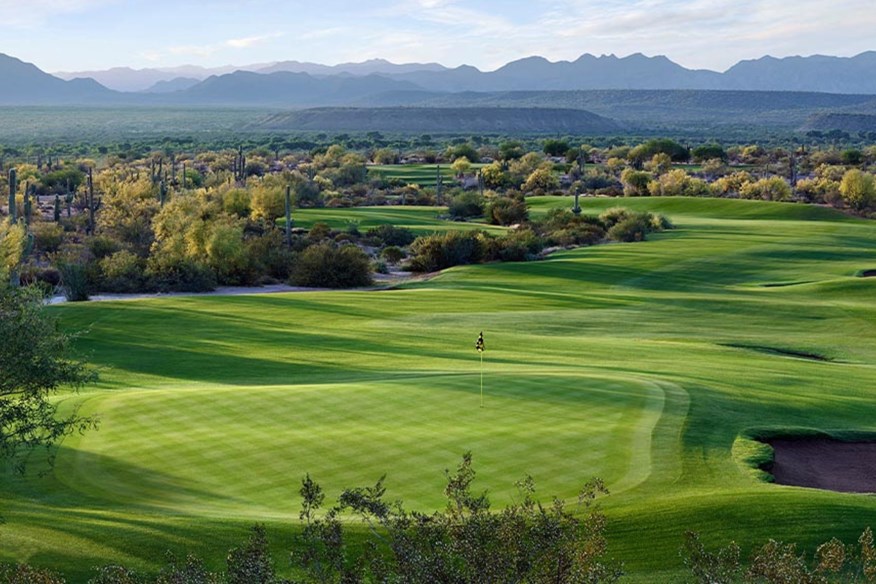
9. We-Ko-Pa (Saguaro)
Course details: 6,966 yards, par 71
Green fee: $299 (for resort guests)
Website: wekopa.com
Telephone: 480-836-9000
We-Ko-Pa was developed by the Fort McDowell Yavapai Nation and is the Yavapai pronunciation for ‘Four Peaks Mountain’ a prominent mountain landmark that sits within the Tonto National Forest about ten miles to the east. There are two courses here – the excellent Scott Miller-designed Cholla Course which opened in 2001 and Bill Coore and Ben Crenshaw’s Saguaro Course which was added to the We-Ko-Pa Casino Resort in 2006.
Coore and Crenshaw had shown what they could do with relatively flat desert land at Talking Stick Golf Club’s North and South Courses (now the O’odham and Piipaash Courses) in 1998. The land they were given at We-ko-Pa, 20 miles east of Scottsdale, had a little more elevation change and, because it’s part of the 25,000-acre Fort McDowell Reservation, sits on sovereign territory with no surrounding houses giving it a real desert wilderness feel. The Saguaro Course is a typically thought-provoking Coore/Crenshaw design with strategically-positioned bunkers and generous fairways that help golfers stay out of the desert but which have preferred sections from which the approach shot is easier.

10. Desert Highlands
Course details: 7,105 yards, par 72
Green fee: Private
Website: deserthighlandsscottsdale.com
Telephone: 480-585-7444
Opened in 1983, the Jack Nicklaus- designed course at Desert Highlands is one of the older, dare we say ‘classic’, desert layouts. It is part of an extremely exclusive club which hosted the first two Skins Games (a once popular televised event with four big-name players that ran from 1983 to 2008) – the first featuring Jack Nicklaus, Tom Watson, Arnold Palmer, and Gary Player. Situated just a few hundred feet south of Pinnacle Peak, the desert scenery is as good here as anywhere and the course conditions typically excellent for a Scottsdale private club.
A number of the fairways are split or have desert washes crossing them at some point calling for more strategy than most desert courses require. Starting in April 2025, the course will begin a $10 million renovation by Nicklaus Design which plans to remodel a few holes, clear the course of overgrown vegetation, and resurface the greens with 007 creeping bentgrass. It follows 2019’s $7 million renovation when the bunkers were rebuilt and the irrigation system was replaced.
Honourable mention
Mirabel – Another beautiful Tom Fazio desert course. Opened in 2001 – (private)
Scottsdale National (Other) – Tim Jackson and David Kahn’s incredible follow-up to their remodel of the Mine Shaft – (private)
TPC Scottsdale – Venue for the (Waste Management) Phoenix Open since 1987. Play the stadium hole with the stands…or the…er…boisterous galleries – (public)
Desert Mountain (all its other courses not in the main list) – Seriously, they’re all really good
Whisper Rock (Upper) – Tom Fazio’s superb Upper Course followed on four years after Phil Mickelson/Gary Stephenson’s Lower Course – (private)
Talking Stick (O’odham) – This Bill Coore and Ben Crenshaw design is a case study on how to build great golf on flat land – (public)





